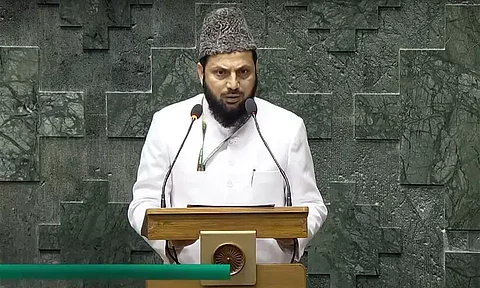

Iftikhar Gilani
In the bustling heart of India’s National Capital Region (NCR), New Delhi, it took Maulana Mohibullah Nadvi almost 20 years to cross a mere 60-foot-wide Red Cross Road.
The road divides the Parliament House Building and the Jama Masjid in New Delhi, where Mohibullah Nadvi, the newly elected member of parliament from Rampur had been leading prayers for the past two decades.
His journey from an imam of a modest mosque unfolded over two decades, not merely in the distance but in dreams realized. His white-painted spiritual haven on the intersection of Parliament Street and Red Cross Road might seem unassuming at first glance.
Leading congregations at this mosque, he had nurtured a vision that one day, he would bridge the physical and metaphorical distance to the pinnacle of the highest political forum in India.
It took him 20 long years, but he finally crossed over from his role as a spiritual guide to a lawmaker, embodying the aspirations of those he led in prayer.
Unlike its majestic Jama Masjid in the old city, this modest, white-painted mosque on the cross-section of Parliament Street and Red Cross Road may not catch the eye, but its significance is deeply felt.
Its imam is also a low-profile person, unlike the Shahi Imam of Jama Masjid of Old Delhi, who is known for having political ambitions.
Mohibullah Nadvi, says, he has bridged these two worlds on a decades-long journey.
Earlier this week, when he had crossed the road to the Parliament to take oath as an MP, at the afternoon prayers, worshipers who had gathered were whispering, whether he will return to lead the prayers now.
The anticipation was palpable. However, to their collective relief and surprise, the 48-year-old Nadvi reappeared, crossing the road to return to lead prayers.
Standing in front of the congregation, Nadvi made a heartfelt announcement: He would continue to lead the prayers five times a day, despite his new duties as a lawmaker.
Nadvi’s journey from the mosque to the corridors of power illustrates a unique story of faith combined with political engagement that resonated deeply within the walls where his political aspirations first took root.
His role as imam brought him into contact with numerous politicians and influential figures. Those who have prayed behind him include the late Dr APJ Abdul Kalam, former president of India, Hamid Ansari, vice president of India, and many others.
These encounters sparked his interest in politics and made him dream of crossing the road between the mosque and the Parliament. He also lived with his family in a two-room hutment inside the mosque.
But that was a difficult undertaking. He had already tried his luck a few times asking politicians to put him up for the provincial elections. But no one took him seriously.
Speaking from New Delhi, Nadvi said the late Shafiqur Rahman Barq, a former MP, had introduced him to Akhilesh Yadav, the leader of the Samajwadi Party.
As the party’s strongman and MP from Rampur, Azam Khan was facing legal challenges, Yadav wanted another Muslim face for the Muslim-dominated Rampur seat.
Despite opposition from within the party, Yadav succeeded in fielding Mohibullah from the Rampur seat, a decision that was vindicated by his victory over incumbent BJP MP Ghanshyam Lodhi by a sizeable margin of 87,000 votes.
Born in the village of Razanagar in the Suar region of Rampur, he had studied at the Madrasa Jameul Uloom Furqania and Darul Uloom Nadwatul Ulama in Lucknow.
He moved to Delhi where he obtained a degree in Arabic and a Master in Islamic Studies from Jamia Millia Islamia. He was appointed Imam of the Parliament Street Mosque on March 28, 2005, by the Delhi Wakf Board.
As a newly elected MP, Mohibullah now plans to use his dual role to improve the lives of his constituents and continue to lead prayers.
He has placed an emphasis on unemployment, healthcare, and education and has expressed his willingness to negotiate with state and central agencies to bring resources to Rampur.
Navigating between the spiritual and the political, Mohibullah says he will continue to devote himself to his duties as an imam, emphasizing that he only has to spend five to six minutes leading prayers.
The mosque’s proximity to Parliament, a short walk, effectively supports his dual responsibilities.
After attending the parliamentary session and leading the afternoon prayers on his first day, he is confident that he can combine these duties seamlessly.
The mosque is believed to have been built during the Mughal period at the foot of the Raisina Hills, which the British later made the seat of their power. It was renovated in 1946 by the Bharat Chemical Works of Calcutta.
Since there is no population in the area, except those who work in government offices, there is no one to look after the mosque. It had started crumbling in various places. Its roof had collapsed, and its walls and gates were in dire need of repairs until a few years ago when M A Yousuf Ali, a businessman from Kerala, visited the mosque and noticed its dilapidated condition.
On his return, he asked his office to prioritize the renovation of the mosque as it is located near the Parliament and is frequented by many visitors.
Maulana Abul Kalam Azad used to pray regularly in this mosque, as did all former presidents Zakir Husain and Fakhruddin Ali Ahmad, especially on Fridays. The grave of Ahmad, who died during his presidential tenure lies beside the mosque.
As it is located almost in the centre of New Delhi, most visiting heads of state and delegations from Islamic countries offer prayers in this mosque.
—–
Have you liked the news article?